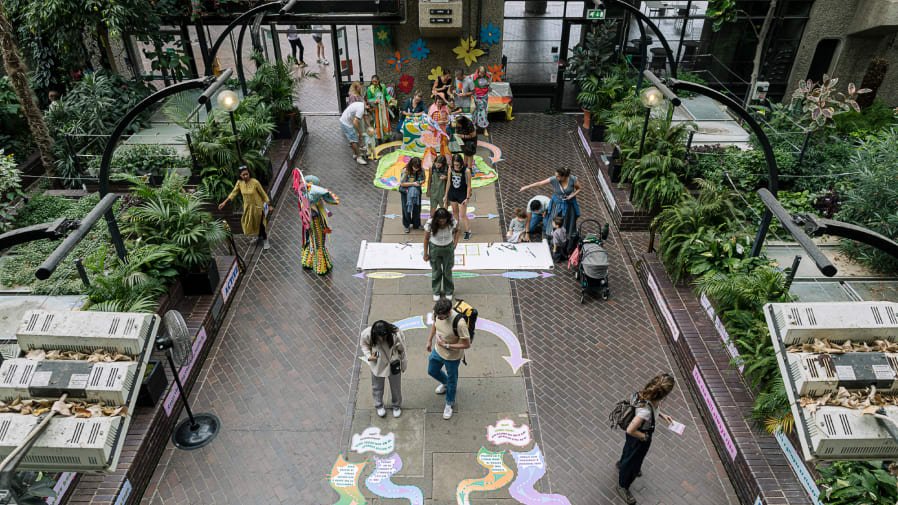Climate Emergency Network: Changing the way we work together
The Climate Emergency Network is non-hierarchical, distributed, and evolving. It's a platform for channelling creativity into climate action across our Colleges, research centres and institutes. Our community includes undergraduate students, professors, support staff, alumni, and friends.
Our purpose is to foster an internal movement for change. We aim to give opportunities for everyone to engage in climate action. We host monthly Climate Cafés and seasonal Climate Circles. We develop campaigns, actions, and activities to show that the arts can, and must, respond to the climate and ecological emergency.
Contact us: climatenetwork@arts.ac.uk.
What we've done so far
Curation and production
We’ve curated:
- an exhibition programme exploring climate justice, hosted in the Lethaby Gallery. The Green House featured over 60 artists exhibiting socially just responses to the impacts of climate change
- pilot projects like a pop-up SWAP SHOP at Central Saint Martins (CSM)
- a series of gatherings, workshops, conversations and interventions to embed our Climate Action Plan in the practices of the UAL community
- UAL Food Regenesis - a collaboration with UAL canteens for a regenerative, plant-based menu
- UAL-wide event programmes that were co-created with 200 students and staff during key moments. This included an alternative summit to COP26, called Carnival of Crisis
- an outdoor exhibition of graduate work for London Design Festival called Material Heroes
- collections of student work as part of our UAL Showcase
- seasonal climate circles, like the one at the Story Garden.
We've produced:
- the Climate Emergency Interactive - a teaching tool to prompt conversations about the climate emergency and what we can do about it, both politically and creatively
- a draped display of 3 60 foot banners by Studio Orta (Fabulae Naturae) which hung at the Granary Building. This highlighted species loss in the UK
- Earth Quest. An eco-inspired journey across the Barbican centre to explore the role of creativity in climate action
- a series of collective experiences in the name of social and ecological justice for Earth Day
- a social impact evaluation of Earth Day: Appetite for Justice (PDF 4.9MB) with Doc Society
- market stall takeovers at Kings Cross' Canopy Market. These presented designers and artists who support socially-minded, environmentally driven design.
Collaboration
We've developed partnerships and worked with organisations across arts and culture, civil society, higher education, and scientific research sectors. This includes:
- Glasgow School of Art
- Culture Declares Emergency
- The Barbican Centre
- V&A Dundee
- Architects Climate Action Network
- King’s Cross Canopy Market
- Citizens UK
- Extinction Rebellion
- FranklinTill
- and more.
We've taken part in nationwide climate campaigns such as COP and Earth Day. We've also promoted and celebrated annual environmental campaigns. Other campaigns include embedding climate justice into our research and Knowledge Exchange and working in conjunction with our Climate Advocates. Want to collaborate? Get in touch.
Events
We’ve brought UAL students and researchers together with scientists, activists, community organisers, artists, poets, illustrators, journalists and more. We support pilot projects and initiatives through a 'living lab' model that create real-world learning and research opportunities for students and staff, while bringing environmental impact to our wider community.
You can follow us on Eventbrite to keep up to date with our latest events. We host events at key points in the University’s calendar. For example, the Big Welcome, when we welcome students at the beginning of the academic year. The Big Welcome tells students about the ways in which sustainability is central to everything we do. This covers our green buildings, energy use, and encouragement to join our Climate Emergency Network.
We also induct students online with an e-induction (PDF 1.75MB). They’re orientated when they check in and get resources to learn about sustainability at UAL.
We also host Climate Circles to mark the changing in seasons and align our collective vision with nature’s own rhythms. A different member of our community facilitates each seasonal event or gathering. These artist-led meetings offer a place to share news, meet like minded creatives, plan activity and support each other.
What we'll do next
We'll:
- build the Climate Emergency Network as a movement of staff and students advocating for change
- work with educational, cultural, government, industry and civil society partners to advocate for change
- develop collaborative and multi-disciplinary approaches to campaigning, advocacy and movement building.






